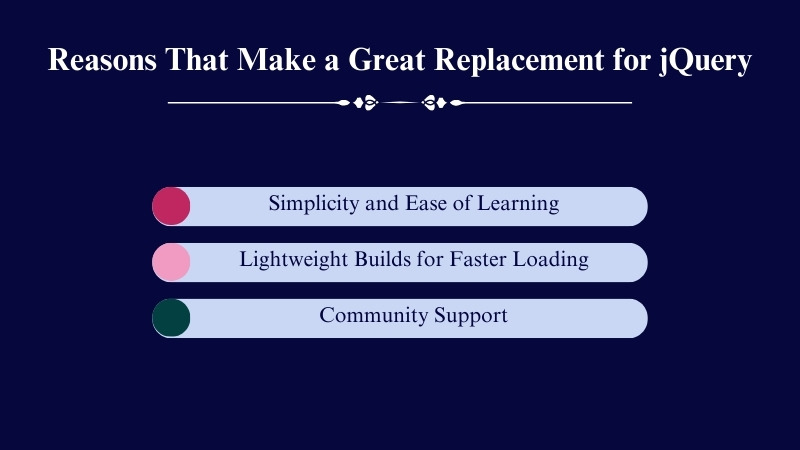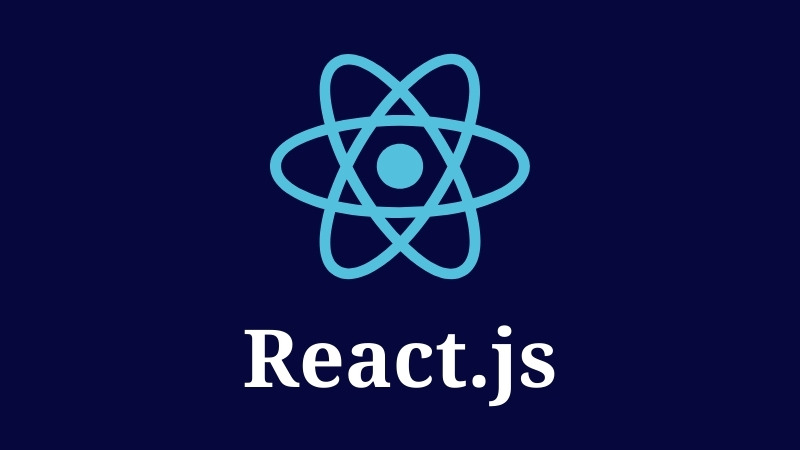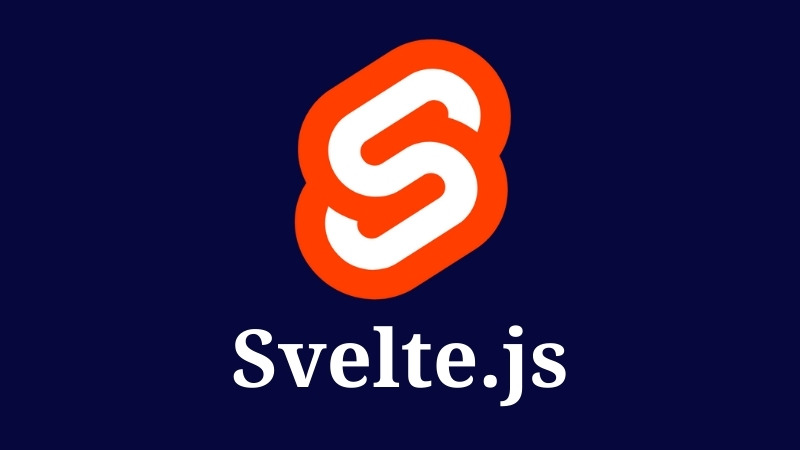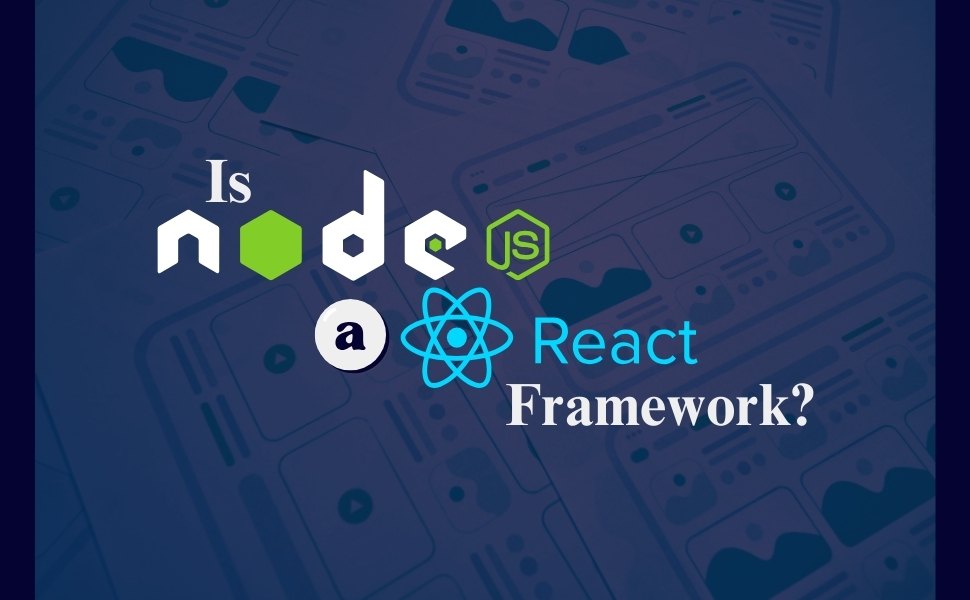There was a time when jQuery ruled the web. It made complex tasks like DOM manipulation, AJAX, and animations easy, and nearly every website had it in its code. Developers loved how it simplified JavaScript and saved them hours of work.
But the web has evolved. Modern JavaScript now offers built-in features that make many of jQuery’s tools unnecessary. On top of that, modern jQuery alternatives have emerged—faster, lighter, and tailored to today’s needs.
So, here’s the question: What’s your favorite replacement for jQuery?
Today, we’ll explore some of the best replacements for jQuery. Whether you’re building a single-page app, a sleek user interface, or a mobile-friendly site, there’s an option that’s just right for you.
By the end, you might even discover a new favorite to add to your developer toolkit. Let’s dive in!
What is jQuery?

jQuery is a fast and lightweight JavaScript library created in 2006. It became one of the most popular front-end development tools, simplifying tasks like HTML manipulation, event handling, and animations with its simple syntax.
Before jQuery, developers wrote long, complex code for basic tasks. jQuery changed that and solved browser compatibility issues, making it a go-to tool for dynamic websites.
While modern JavaScript frameworks like React and Vue have largely replaced it, jQuery was a game-changer in its time and remains a part of web development history.
Why Are We Moving Away from jQuery?
If you’ve found yourself asking, “Do I really need jQuery?” or even “Is jQuery dead?”, you’re not alone.
Here’s why many developers are switching to modern JavaScript frameworks and lightweight jQuery substitutes—
1. Modern JavaScript is Better Than jQuery
Native JavaScript APIs have come a long way. Tasks that used to require jQuery—like selecting elements or making AJAX requests are now super simple with vanilla JavaScript. Functions like querySelector or the fetch API do the same job, often faster and without the extra library.
2. Powerful Frameworks Are Everywhere
Frameworks like React, Angular, and Vue, aren’t just buzzwords—they’re redefining web development. These JavaScript libraries replace jQuery by offering much more than jQuery ever could. From building dynamic UIs to managing complex application states, these tools are in a league of their own.
3. Performance Matters
Modern web apps need to be fast. Every kilobyte counts when it comes to loading times. At around 90KB, jQuery is bulky compared to lightweight jQuery alternatives. Developers are choosing tools that perform better without slowing down websites.
4. The Web Has Evolved
jQuery was created when browser inconsistencies were a huge problem. Today, browsers are more standardized, and most of jQuery’s polyfills are no longer needed. This means developers can achieve the same results with less code using modern jQuery alternatives.
What Makes a Great Replacement for jQuery?

Looking for the best replacement for jQuery? Here’s what you should keep in mind. It’s not just about swapping one tool for another; it’s about finding the right fit for your needs. Let’s break it down—
1. Simplicity and Ease of Learning
jQuery was popular because it was simple. It didn’t matter if you were a beginner or a pro—you could pick it up quickly. Any jQuery alternative should offer the same ease of use. Tools like Alpine.js and Vue.js are great examples. They keep things straightforward, making them perfect for developers who want results without a steep learning curve.
The learning curve may be steeper for those diving into frameworks like React or Angular, but they have their own benefits, like reusable components and scalability. Pick a tool that matches your comfort level if you’re just starting.
2. Lightweight Builds for Faster Loading
Web users don’t like waiting, and neither do developers. Every extra kilobyte on a website affects loading speed, which impacts user experience and search engine rankings.
jQuery is about 90KB minified. That’s not huge, but it’s bigger than many modern jQuery alternatives. For example—
- Alpine.js is just around 10KB.
- Zepto.js, a lightweight jQuery substitute, is also under 30KB.
These smaller libraries load faster, which is especially important for mobile users. When speed matters, a lightweight replacement for jQuery is a big win.
3. Community Support: Because No One Likes Feeling Stuck!
Let’s face it—you’ll hit roadblocks no matter how experienced you are. That’s where a strong developer community makes all the difference.
jQuery thrived because of its massive community. Today, modern JavaScript frameworks like React, Vue, and Angular have equally passionate developer bases. They come with—
- Tons of documentation.
- Countless tutorials and guides.
- Active forums and Q&A sites like Stack Overflow.
When choosing a jQuery alternative, make sure there’s plenty of support. It’s comforting to know someone out there who’s faced the same issue and has a solution.
Before choosing an alternative for jQuery, check out these helpful comparisons—
These resources can give you deeper insights into how jQuery compares to other tools, helping you make the best decision for your project.
Popular jQuery Alternatives: Which One’s Your Favorite?

With so many options to replace jQuery, it can be hard to choose. Let’s take a look at some of the most popular jQuery alternatives. Have you tried any of these yet?
1. React.js

Have you jumped on React yet? React is one of the most popular JavaScript libraries out there. It’s not just a replacement for jQuery—it’s a game-changer for building user interfaces.
React uses a component-based structure, which makes your code reusable and easy to manage. Instead of updating the DOM directly, React uses a virtual DOM for lightning-fast performance. Facebook backs it, so you know it’s here to stay.
React is perfect for dynamic web apps where speed and responsiveness matter. If you’ve worked with jQuery for animations or UI updates, React offers a more modern, scalable way to do the same thing—and more.
2. Vue.js

Vue might be your pick if you’re looking for simplicity and elegance. Vue is a progressive javascript front-end framework and a fantastic modern jQuery alternative. It’s incredibly easy to learn, especially if you’re transitioning from jQuery.
Vue is loved for its flexibility. You can use it for small projects or scale it up to handle complex web applications. Its syntax is straightforward, so you don’t need to be a JavaScript wizard to get started.
Plus, Vue’s ecosystem is packed with state management and routing tools, making it one of the most well-rounded front-end development tools. Developers love it for being intuitive and beginner-friendly.
3. Angular

Angularjs framework has its perks for the all-in-one crowd—just be ready for the learning curve. Angular is a full-fledged framework maintained by Google. It’s perfect for building large-scale, single-page applications.
Unlike jQuery, Angular is a complete package. It handles everything from templating to data binding and even state management. These Angular features make it an excellent choice for developers who need a robust, enterprise-level solution.
That said, it can feel overwhelming if you’re coming from jQuery. However, for teams looking for a powerful, scalable framework, Angular is a strong contender among modern JavaScript frameworks.
4. Alpine.js

Do you prefer something lightweight and reactive? Alpine.js might surprise you. Think of it as the modern, minimal cousin of jQuery. It lets you add interactivity directly into your HTML without a lot of extra setup.
Alpine.js is perfect for small projects or cases where you want to avoid the complexity of larger frameworks. It’s reactive and declarative, much like Vue or React, but with a much smaller footprint.
If you love jQuery for its simplicity, you’ll appreciate Alpine’s “just enough JavaScript” approach. It’s one of the best lightweight jQuery substitutes for developers seeking simplicity.
Read More: HTML Front-endFrameworks.
5. Zepto.js

Do you miss the simplicity of jQuery? Zepto feels like its modern, mobile-first cousin. It’s a minimalist library that mimics much of jQuery’s functionality while being much lighter.
Zepto is specifically designed for modern browsers, so it skips the extra code needed for old browser compatibility. It’s a great choice if you’re building a mobile-first web app and want to keep things fast and lightweight.
Zepto is a great jQuery alternative for developers who want to use a familiar syntax like jQuery without the bulk.
These are just a few of the best replacements for jQuery. Each one has its strengths, so the best choice depends on your project and goals. What about you? Have you found your favorite yet? Let us know!
To learn more about mobile app development frameworks, check this out—
Top 10 Mobile App Development Frameworks.
Hidden Gems for Replacing jQuery
When it comes to finding a replacement for jQuery, big names like React and Vue often steal the spotlight. But there are other exciting jQuery alternatives worth exploring. These tools may not have the same name recognition, but they bring fresh ideas and innovative approaches to modern web development.
1. Svelte.js

Have you heard about Svelte? It’s becoming a favorite among developers looking for a modern jQuery alternative. Unlike React or Vue, Svelte doesn’t use a virtual DOM. Instead, it compiles your code into super-efficient JavaScript at build time. This makes your apps faster and lighter right out of the box.
Svelte is an open-source framework that’s perfect for developers who want a clean and simple way to build user interfaces. Its syntax is intuitive, and there’s less boilerplate code to worry about. If you’re tired of complex setups, Svelte might be exactly what you’re looking for.
Its popularity is growing quickly, supported by a passionate community of developers. For those seeking innovation among modern JavaScript frameworks, Svelte is worth a try. Who knows? It might become your favorite replacement for jQuery.
2. Native JavaScript

Sometimes, the best replacement is… no replacement at all. Modern JavaScript has come a long way since jQuery’s early days. JQuery was famous for many things—like selecting elements, adding classes, or making AJAX calls can now be done easily with vanilla JavaScript.
Here are a few examples—
- Instead of $() for selecting elements, use document.querySelector().
- Replace $.ajax() with the fetch API for network requests.
- Use classList for adding or removing classes.
Native JavaScript is lightweight and doesn’t require any external libraries. This makes it one of the best lightweight jQuery substitutes, especially for smaller projects or situations where you want complete control over your code.
Svelte brings innovation, and native JavaScript keeps things simple. Why not give them a shot? Who knows? Your next favorite replacement for jQuery might be just around the corner!
Ready to Make the Switch?
Switching from jQuery isn’t scary. It might feel like a big change, especially if you’ve relied on it for years. But with the right approach, you can transition smoothly—and even enjoy the process!
Replacing jQuery with modern tools is an important step in any web development roadmap.
Here are some tips to help you get started with a replacement for jQuery—
1. Take It One Step at a Time
You don’t have to replace jQuery all at once. Start small. Focus on one feature at a time. For example—
- Replace a simple DOM manipulation with native JavaScript or a new library.
- Swap out $.ajax() calls with the modern fetch API.
Gradual changes will make the transition feel less overwhelming and help you explore jQuery alternatives at your own pace.
2. Use Tools Like jQuery Migrate
If you’re working on an older project with heavy jQuery usage, tools like jQuery Migrate can be a lifesaver. It’s designed to help you identify outdated code and provides a smooth way to upgrade to newer versions of jQuery—or replace it entirely with a modern jQuery alternative.
This tool flags deprecated features and offers solutions, so you don’t have to comb through everything manually. It’s especially helpful for large projects where jQuery is deeply embedded.
3. Explore Libraries for Specific Needs
Think about what features you use most. If you’re replacing jQuery, pick a tool tailored to your project’s requirements. For example—
- Need better DOM manipulation? Try Alpine.js or Vanilla JavaScript as lightweight jQuery substitutes.
- Want a complete framework for UI development? Consider React, Vue.js, or even Svelte as modern JavaScript frameworks.
Choosing the right jQuery alternatives will make your code more efficient and modern.
4. Test as You Go
As you start replacing parts of jQuery, test your changes regularly. This ensures everything works as expected and helps you catch bugs early. Testing in small chunks will save time and keep your project stable while adopting the best replacement for jQuery.
5. Stay Patient and Keep Learning
Switching tools takes time, especially if you’re diving into something new like React or Svelte. Be patient with yourself. Use resources like documentation, forums, and tutorials to guide you.
Making the switch away from jQuery is a chance to grow as a developer and embrace modern jQuery alternatives. It’s not just about replacing old code—it’s about building something faster, leaner, and better suited for today’s web.
Remember, every developer has been in your shoes at some point. With consistent effort, you’ll feel confident in no time.
What’s Your Favorite Replacement For jQuery?

At the end of the day, there’s no single answer. The best replacement for jQuery is the one that works for you. Some developers swear by the flexibility of Vue, while others love React for its scalability. Maybe Alpine.js or Svelte has won you over with its simplicity. Or perhaps you’ve found that native JavaScript covers all your needs.
What’s important is finding the right tool for your goals. That’s the beauty of modern web development—there’s a solution for everyone.
Let us know—
- What’s your favorite replacement for jQuery, and why?
- What’s worked well for your projects?
- Have you discovered a tool you’d recommend to others?
The conversation doesn’t have to end here. Click this button to contact us and keep it going.
Final Thought
jQuery was a game-changer in its time, but the web has moved forward. Today, modern jQuery alternatives like React, Vue, Alpine.js, and even native JavaScript offer faster, more efficient solutions for developers. Each jQuery alternative has its own strengths, and the best replacement for jQuery depends on your project’s needs and personal preferences.
Switching from jQuery is not just about updating your tools—it’s about embracing the evolution and future of web development. So, explore your options, try new libraries, and find what works best for you.
Read More Articles:








